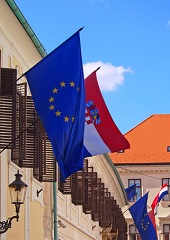Sizing Up Europe
What is the average population size of an EU country? 5, 10, 20 or 40 million?
July 20, 2013

On July 1, 2013, the European Union added a new member, Croatia. Formerly a part of Yugoslavia, this nation of 4.4 million people became the EU’s 28th member country.
We wonder: What is the average population size of an EU country?
[toggle title_open=”A. Under 5 million is not correct” title_closed=”A. Under 5 million”]
The accession of Croatia to the European Union on July 1, 2013, increased the EU’s land area by 1.3%, its population by 0.87% and the size of its economy by just 0.35%. Of the now-28 members of the EU, nine of them — nearly a third of the total — have a population of less than five million.
Ireland, at 4.6 million people, is currently the EU’s 20th most populous country and closest to Croatia in population size.
Two of these smaller EU members — Luxembourg and Malta — have populations below one million. Another EU country, Cyprus, barely exceeds the one-million mark. Interestingly, all of these small countries have run into significant problems during the recent financial crisis because of their oversized financial sectors.[/toggle]
[toggle title_open=”B. Under 10 million is not correct” title_closed=”B. Under 10 million”]
Altogether, 16 of the EU’s 28 members have populations of less than ten million people. By comparison, 43 of the 50 U.S. states have populations below that level.
Seven EU members are in the 5-10 million population range. The one closest to the ten million level is Hungary, with 9.9 million people. An EU member since 2004, and like Croatia a country previously behind the “Iron Curtain,” Hungary long stood out for being a relatively liberal country during Communist times.
In recent years, however, under the leadership of Prime Minister Viktor Orbán, the country’s constitution has been amended to enact measures that concentrate power in the hands of his political party (Fidesz), limit the independence of the judiciary and the media, and other measures that have drawn criticism from Hungary’s EU partners.[/toggle]
[toggle title_open=”C. 18 million is correct” title_closed=”C. 18 million”]
The average population size of the now 28 EU member countries is 18.1 million. The countries closest to that average are Romania (at 21.4 million), which joined the EU in 2007, and the Netherlands (at 16.7 million), which is one of the six founding members of the EU. They are the EU’s seventh- and eighth-most populous countries.
The Netherlands is among the EU’s most prosperous countries (with a per capita GDP of $49,660), but has had to cope with weak economic growth in recent years as a result of the bursting of the country’s housing bubble.
Romania is one of the EU’s poorest member countries in terms of per capita GDP, at $8,140. This compares to $13,540 for Croatia. Romania’s post-Cold War economic transformation has been hampered by widespread corruption, cronyism and political turmoil.
In the United States, New York and Florida — the country’s third- and fourth-most populous states, with populations of about 19.5 million — are right around the EU members’ average population size. That means that only the two largest U.S. states — California and Texas — have populations that exceed the EU members’ average population.[/toggle]
[toggle title_open=”D. 38 million is not correct” title_closed=”D. 38 million”]
Poland has 38.5 million people. That makes it the smallest of the EU’s “Big Six” in terms of population, behind Germany, the United Kingdom, France, Italy and Spain.
Poland is not just the biggest success story of former Communist countries in the post-Cold War environment. In recent years, it has also been the economic success story of Europe in general. According to the country’s finance ministry, Poland registered a 15.8% increase in GDP during Europe’s economic crisis years of 2008-11. The GDP of the entire European Union shrank by 0.5% during the same period.
Sustaining that level of growth will become more difficult as the massive wave of investments in the country’s infrastructure and other catch-up measures are completed.[/toggle]
Takeaways
The addition of Croatia increased the EU’s land area by 1.3%, its population by 0.87% and the size of its economy by just 0.35%.
Of the now-28 members of the EU, nine of them have a population of less than five million.
Sixteen of the EU's 28 members have populations of less than ten million people.
only the two largest U.S. states (California and Texas) have populations that exceed the EU members' average population.
Author
The Globalist
Read previous

Egypt, Wheat and Revolutions
July 19, 2013